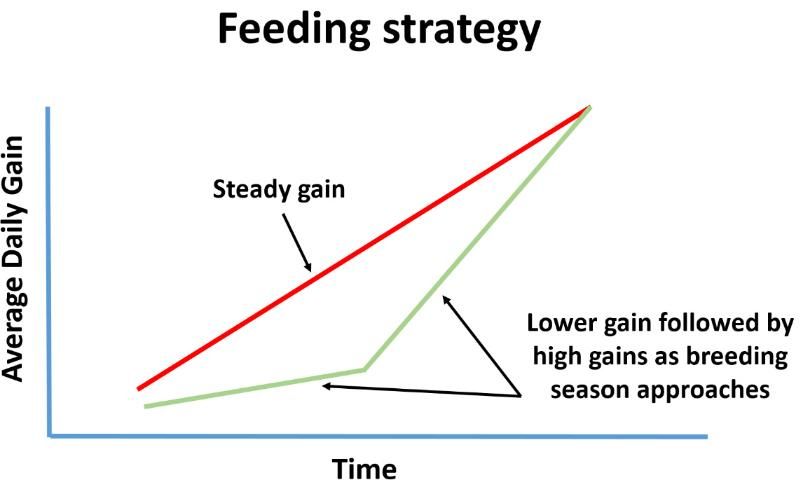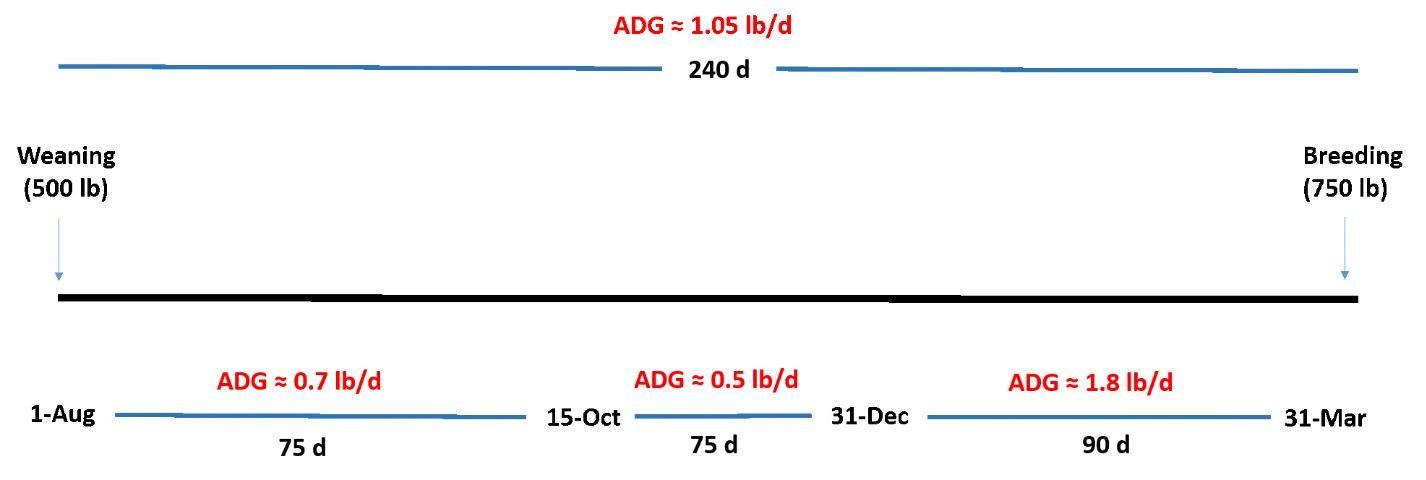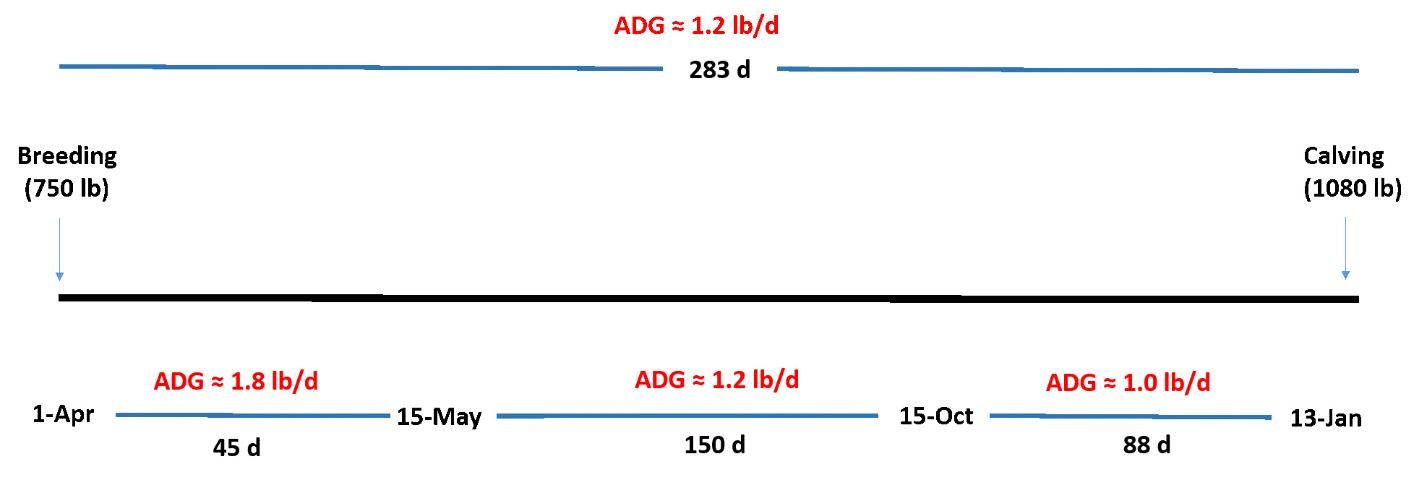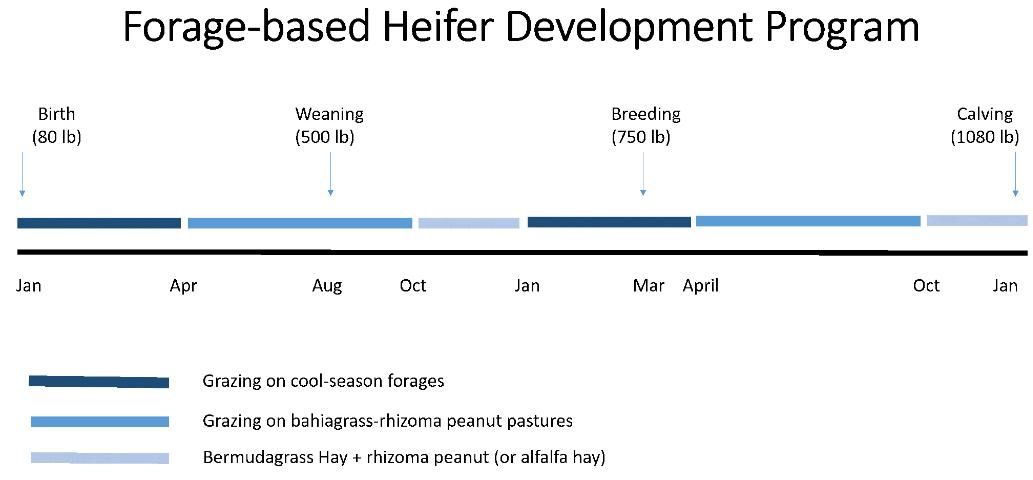Forage-Based Heifer Development Program for North Florida
Introduction
Florida has approximately 915,000 beef cows and 125,000 replacement beef heifers (USDA 2016). Developing these heifers to become productive females in the cow herd is a tremendous investment in a cow-calf operation that takes several years to make a return. Fortunately, there are several options to develop heifers on forage-based programs that can help reduce costs while meeting required industry performance targets. Mild winters in Florida allow the use of cool-season forages that may significantly enhance the performance of grazing heifers. During the warm season, integration of forage legumes into grazing systems provides additional nutrients to meet the replacement heifer's requirements, allowing her to become pregnant and enter the cow herd. This document proposes a model for replacement heifer development based on forage research trials at the UF/IFAS North Florida Research and Education Center (UF/IFAS NFREC) in Marianna, FL.
Planning is essential for establishing a management plan to develop heifers on forage-based diets. A few benchmarks were established to ensure that the heifer would calve at 24 months of age. We assumed weaning weights of 500 lb at 7 months of age, breeding at 750 lb (62.5% of mature weight), and mature weight of 1,200 lb. These numbers could change based on the needs of each farm. Each phase has a different target based on the forages available during the season and the expected weight gain required to reach the desired performance standard. While the development phase is critical in a replacement heifer's life, producers must continue to manage these heifers after calving. Lactating first-calf heifers must overcome postpartum anestrus, rebreed, and continue to grow until they reach mature weight. Figure 1 shows the overall roadmap for a forage-based heifer development program. This document breaks down the roadmap into specific phases and provides details relevant to forage programs in each phase.

Credit: Jose Dubeux, UF/IFAS
From Birth to Weaning
At UF/IFAS NFREC, the calving season takes place during January and February. We use that time frame to select the best forages available to meet the high nutrient requirements of cows at the peak of their lactation. During this time, cool-season forages are available and can provide high nutrition for these cows, resulting in a shortened postpartum interval as well as greater milk production. If we break down Figure 1 and focus only on this phase (January to August), we will also have to use some warm-season pastures to supply forages for the cow-calf pairs from May to August (Figure 2). It is typically possible to graze cool-season forages until the end of May in north Florida. From May to August, cow-calf pairs could graze bahiagrass or bahiagrass-rhizoma peanut pastures to improve nutrition. Cows have lower nutritional requirements toward the end of lactation. Therefore, well-managed warm-season pastures provide enough nutrients to meet the requirements during this phase.

Credit: Jose Dubeux, UF/IFAS
From Weaning to Breeding
Weaned calves face weaning stress, a warm summer, and lower-quality forages, which result in lower gains. However, there are ways to overcome these factors and recover weight later in the season. Research results in other regions of the US compared steady gains vs. lower gains in the initial phase and greater gains when approaching the breeding season (Figure 3). The results indicate that both programs can be adopted and yield similar results in reproductive performance of heifers, as long as heifers gain and meet a minimal body weight prior to the breeding season (Freetly, Ferrell, and Jenkins 2001). At UF/IFAS NFREC, heifers are developed using this approach. Therefore, the low-high gain model would be more applicable to match the timing of weaning and available forages during that time.

Credit: Freetly, Ferrell, and Jenkins (2001)
Bos taurus heifers generally reach puberty at 55–60% of their expected mature body weight, while Bos indicus-influenced heifers typically attain puberty around 60–65% of their mature body weight. Heifers should be developed with targeted gains to allow for the attainment of puberty prior to the beginning of the breeding season (Lancaster and Lamb 2014). In order to reach that target body weight, weaned heifers could graze bahiagrass-rhizoma peanut pastures and have an average daily gain of 0.7 lb/day from August to October. Growing steers at UF/IFAS NFREC have experienced similar gain. Yearling animals would gain twice as much on a similar pasture without concentrate. However, one would expect gains to be much lower during the summer months due to weaning stress, greater nutrient requirements, and limited intake. From mid-October to the end of December, the heifers could receive bermudagrass and rhizoma peanut hays with a target average daily gain of 0.5 lb/day. From January until the end of March, when they would breed, they would graze cool-season forages, with an expected gain of 1.8 lb/day (Dubeux et al. 2016). The heifers would gain 252 lb in 240 days, averaging 1.05 lb/day from weaning to breeding (Figure 4).

Credit: Jose Dubeux, UF/IFAS
From Breeding to Calving
Heifers should calve at 85–90% of their mature body weight. In order to reach that goal, we must target an average daily gain of 1.2 lb/day from breeding to calving (Figure 5). Since they will be bred in the spring (late March), they can continue on cool-season forages until May with an average daily gain of 1.8 lb/day (Dubeux et al. 2016). During the warm season, these yearling heifers will perform much better than weaned calves on bahiagrass-rhizoma perennial peanut pastures. Our data show gains of 1.23 lb/day on bahiagrass-rhizoma peanut pastures for growing steers (Dubeux et al. 2018), but we projected 1.2 lb/day from May until mid-October. After October, the heifers could be fed bermudagrass and rhizoma peanut hay again until calving with an expected average daily gain of 1.0 lb/day because of greater intake. Although no animal performance data have been generated by the authors when feeding bermudagrass and rhizoma peanut hay only, studies conducted at UF/IFAS NFREC showed that growing heifers fed bermudagrass hay and supplemented with 0.3% of their BW/day with a high-protein meal gained 0.9 lb/day over two consecutive years (Schulmeister et al. 2017). The rhizoma peanut hay should provide the additional protein required for the gain. Further studies are needed to confirm this. The total projected gain during the 283 days using this program would be 349 lb, with an average daily gain of 1.23 lb/day.

Credit: Jose Dubeux, UF/IFAS
Conclusion
It is possible to have a forage-based program to develop heifers in Florida. Cool-season forages and the introduction of forage legumes during the warm season and transition periods are important to ensure target gains. In north Florida, integration of crop and livestock systems offers an opportunity to use the land during the fallow period when heifers could have access to cool-season forages. The feasibility of concentrate feeding or forage-based diets is highly dependent on the economics of both systems. Consider the economic needs and constraints of your operation and plan accordingly.

Credit: Jose Dubeux, UF/IFAS
References
Dubeux, Jr., J. C. B., N. DiLorenzo, A. Blount, C. Mackowiak, E. R. S. Santos, H. M. S. Silva, M. Ruiz-Moreno, and T. Schulmeister. 2016. "Animal performance and pasture characteristics on cool-season annual grass mixtures in north Florida." Crop Sci. 56: 2841–2852.
Dubeux, Jr., J. C. B., L. E. Sollenberger, J. M. B. Vendramini, M. Wallau, A. Blount, L. Garcia-Jimenez, E. R. S. Santos, and D. Jaramillo. 2018. Strip-Planting Rhizoma Peanut into Grazing Systems. SS-AGR-421. Gainesville: University of Florida Institute of Food and Agricultural Sciences. https://edis.ifas.ufl.edu/ag421
Freetly, H. C., C. L. Ferrell, and T. G. Jenkins. 2001. "Production performance of beef cows raised on three different nutritionally controlled heifer development programs." J. Anim. Sci. 79: 819–826.
Lancaster, P. and C. Lamb. 2014. Targeting ADG of Developing Replacement Heifers Using Age and Body Weight. AN305. Gainesville: University of Florida Institute of Food and Agricultural Sciences. https://edis.ifas.ufl.edu/an305
NASEM. 2016. Nutrient Requirements of Beef Cattle: Eighth Revised Edition. Washington, D.C.: The National Academies Press. doi: 10.17226/19014.
Schulmeister, T. M., M. Ruiz-Moreno, G. Medeiros, M. Garcia-Ascolani, F. M. Ciriaco, D. D. Henry, G. C. Lamb, J. C. B. Dubeux, Jr., and N. DiLorenzo. 2017. "Evaluation of Brassica carinata as a protein supplement for growing beef heifers." In 2017 Florida Beef Research Report. 107–110. Gainesville: University of Florida Institute of Food and Agricultural Sciences. http://animal.ifas.ufl.edu/beef_extension/reports/2017/docs/2017_Florida_Beef_Research_Report.pdf
USDA. 2016. "Florida cattle facts." U.S. Department of Agriculture—National Agricultural Statistics Service. Accessed on October 17, 2018. https://www.nass.usda.gov/Statistics_by_State/Florida/Publications/Brochures/FL%20Cattle%20Broc%202016.pdf



